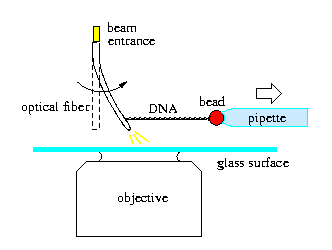mpi
Micro Pipette Sensors
Micropipette Sensors are made using very thin glass capillary needles
typically one micron thin and a millimeter long. These flexible
devices are very easily bent by a small force pulling them
perpendicularly away from their axis
[1]. To build such a sensor
requires a means to detect the small displacement of the needle: this
may be done optically by analyzing the video image of the needle or by
using an optical fiber
[2] as the needle and imaging the light spot at
the end of the needle on a four-quadrant diode detector
[3].
The force sensitivity of a Micropipette Sensor is related to its
stiffness. Typically on the order of 10-5 N/m, or 10 pN per micron of
dislacement. A very common error consists in saying that the best
sensor is the one with the smallest stiffness. We shall see that the
best sensor (in term of signal to noise) in in fact the smallest
device. Since the Micropipette is rather long compared to other
sensors, they are usually not the best.
| |
Bibliography |
| 1 | SINGLE-MOLECULE ANALYSIS OF THE ACTOMYOSIN MOTOR USING NANO-MANIPULATION
A. Ishijima, Y. Harada, H. Kojima, T. Funatsu, H. Higuchi, T. Yanagida,
Biochem. Biophys. Res. Commun.
(1994) 199-2 p.1057 PubMed CrosRef
|
| 2 | DNA: An extensible molecule
P. Cluzel, A. Lebrun, C. Heller, R. Lavery, JL. Viovy, D. Chatenay, F. Caron,
Science
(1996) 271-5250 p.792 Science publications
CrosRef
|
| 3 | Mechanical separation of the complementary strands of DNA
B. Essevazroulet, U. Bockelmann, F. Heslot,
Proc. Natl. Acad. Sci. U. S. A.
(1997) 94-22 p.11935 PNAS publications
CrosRef
|
For further information please contact 

